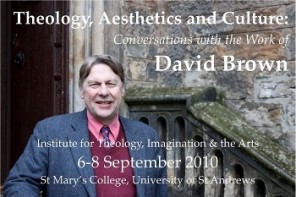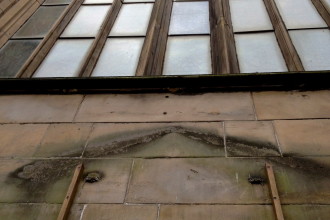One of the reasons for naming this blog Transpositions is that all of us are interested in creative transpositions between the arts and Christianity, exploring ways that the arts inform Christianity and vice versa. Although this type of transposition has grown more popular in recent years, there remains a shortage of reflection about how these transpositions actually work. What are the methods for putting the arts in conversation with Christian thought and practice? How do we describe the relationship between the arts and Christianity in the context of interdisciplinary studies?
One relationship we should discount right away is illustration. If we are going to take the conversation between the arts and Christianity seriously, we have to move beyond thinking about the arts as mere illustrative tools for theological reality. Even though Christians are really good at “finding God at the movies” and other methods of mining the arts for truth, I believe that the arts have more to offer than this.
Another option is to treat the arts as metaphors for Christianity. Since a metaphor is speaking of something in the terms of something else, this means speaking about Christianity in the terms of art. Since metaphors are linguistic devices, however, this only gets us so far. For example, “Christian living is improvisation” may be a helpful metaphor, but improvisation as an embodied practice provides a lot more than a different way of speaking about Christianity.
What about analogy? Generally speaking, an analogy is often used to describe the relationship between two things that have a greater similarity than a metaphor. For example, saying ‘God is good’ is an analogy because even though God is not exactly ‘good’ as we understand it, describing him that way is not too strange. But saying ‘God is a playwright’ surprises us because ‘playwright’ is different enough from ‘God’ to make it a metaphor. So, the arts may inform Christianity as analogies at times, but it still misses the mark.
Identifying the arts as models for Christianity, however, has much more promise. In contrast to a metaphor, a model is an object or state of affairs rather than a linguistic devices. For example, I might say that building a house is a model for nurturing Christian community, because I am referring to the entire set of activities involved in building a house. Consequently, models are more conceptual and holistic, and can be unpacked using lots of metaphors. If theatrical improvisation is a model for Christian living, it means that all the concepts and practices associated with theatrical improvisation provide a new way of thinking about and practicing Christianity. When I describe this model, I use many different metaphors (God is a director, the church is an improv troupe, the world is a stage, etc.), but improvisation remains a comprehensive model for Christian living. And if this model would become the dominant way of talking about Christianity in certain circles, it would be appropriate to call this model a paradigm.
In sum, I am suggesting that the arts inform Christianity by providing new, creative models with the potential to transform Christian thought and practice, maybe even becoming paradigms. Of course, it is incredibly important to remember that the arts are valuable on their own terms. The arts do not need to be transposed into Christian thought and practice in order to be appreciated. But when we appreciate the arts for what they are, we realize that Christianity has much to learn from paying close attention to the arts. Having done so, the arts can provide models that invigorate our imaginations, generate new insights, and motivate more fitting ways of living. I am still learning how to transpose, so I would appreciate your thoughts on any of this and your perspectives on how the arts inform Christianity.





I’ve been doing a lot of thinking lately about the idea of art as prophecy. I’m increasingly convinced that the highest calling of artists is to be the prophetic voice of God speaking to the church and culture.
I think the problem with calling the arts a model for Christian faith is that it still leaves a gap between those who consider themselves artists and those who don’t. I think the arts have a deeper role to play than simply providing insight into our personal faith. I think the arts–and the artists who produce them–speak to and challenge the corporate body of believers to strive for something more. At their best the arts, to borrow from pastor and author Mark Labberton, help us have an imagination for the Kingdom of God.
I think you are absolutely right, Jonathan, that artists can be prophetic voices of God in our churches and culture. I also agree that the arts challenge us to strive for something more, which they can do as models and the way they enliven our imaginations.
I probably should have clarified that the different approaches I am exploring in this post are more the ways the arts and Christianity relate in an academic context, or how the arts and Christianity relate in interdisciplinary studies. I certainly agree that the arts have many other roles and functions in the life of the church and individual Christians.
Ah, then that does make more sense to look at the arts as more of a theoretical model.
I like the Stuckist movement definition of “true art” as “man’s desire to communicate with himself, his fellows and his God.” I think it allows us to explore any work of art and ask what was the intention of the artist; what was the artist trying to communicate and to what degree does it resonate with us. And since Christian artists do not own a monopoly on expressions of the sacred and divine it even leaves open the door for us to engage with art and artists outside of the church.
Thanks for this interesting post about approaches to interdisciplinary work in theology and the arts. As you know, I think the use of models is helpful within theological methodology, but I am struggling to see how we could identify the arts as models. I guess it is the very general use of the word ‘arts’ that I find troubling. Basically I’m not confident that all of ‘the arts’ in general can be models for Christianity because one requirement of a model is that it be systematizable. I see systematization as the main difference between a model and a metaphor (because while you are right to point out that models can be physical objects, I think they can also be linguistic. By the way, isn’t this implied in your use of ‘the arts’ since that would certainly include literature or other art forms that employ words). So, some metaphors do not lend themselves to systematization. For example, ‘God is rock’ is a fine metaphor, but it makes a poor model. Why should we consider ‘the arts’ in general to be adequate for models? Wouldn’t we need to consider particular examples, suggesting that your approaches might not necessarily exist on a scale from worse to best?
I would agree that approaching works of art as merely illustrations of the theological points I want to make does not lead to truly interdisciplinary work because the two disciplines don’t appear to be talking to each other. Nevetheless, why should we always discourage illustration? Theologians use diagrams all of the time, and we could simply substitute a work of art for a diagram. I suppose the real danger in this is that we encourage a truncated way of interpreting and appreciating works of art.
Also, how do you think the notion of the work of art as a text of or for theology fits into this schema? I think it might need to be fleshed out, but I think that ‘text’ and ‘model’ could be compatible sorts of concepts. But, for the moment, it easier for me to see how a painting might be a ‘text’ of or for theology, while it is easier for me to see how the whole practice of theatre might serve as a ‘model’ for theology.
Thanks for these thoughts, Jim, which really help me to clarify this. When I refer to ‘the arts’ as models for Christianity I am thinking of particular forms of art, such as theatrical improvisation. And you are right that some art forms provide more appropriate models than others.
I also think it would be important to add that the arts can be ‘modes’ for Christian thought and practice. Literature is one example, and is often utilized as a mode for doing theology. Is that what you mean by particular forms of art providing a ‘text’ for theology, or do you mean something different?
I was not referring to forms of art (or maybe better put forms of artistic practice?) as a ‘text’ for theology, I was thinking of individual paintings, books, movies etc. as texts for theology. So, for example, one could think of ‘Guernica’ as a ‘text about’ the crucifixion, and so it could become a source for theology and also challenge our theology of the crucifixion. A less controversial example could be Grunewald’s Isenheim Altarpiece. This is clearly a set of paintings about crucifixion and resurrection. It becomes a text for theology to the extent that it shapes, influences or challenges the way that theologians talk about crucifixion and resurrection. But I hesitate to say that either Guernica or Grunewald’s Isenheim Altarpiece are models for theology. This is because they are not systematic enough: they might shed some light on one aspect of the crucifixion that we had not thought of before, but can they be models?
Thanks for clarifying your general use of ‘the arts,’ but again ‘forms of art’ might also be problematic given the abundance of ‘forms of art’ that exist today. So, again, are all ‘forms of art’ suitable for use as models of theology? Perhaps some are simply not rich enough to be systematizable.
Furthermore, you clarification ‘forms of art’ suggests that you are not interested in the products of artistic practice, but the actual practices themselves (I recognize the line between product and practice is blurred in some cases (for example, in participatory art forms where the work of art is the very process of its becoming), but it seems to me that we can tentatively hold this distinction). So, then, would it be right to further clarify your post by saying that you are interested in transpositions between ‘the forms of art’ and Christianity, but that this post is not meant to apply to transpositions between ‘the products of the forms of art’ and Christianity?
If the above is the case, then it might seem that ‘text’ is a more appropriate way of talking about works of art (the products) then it is about the forms of art (the practice), and so we need not really consider its relation to models (at least for the purposes of this post).
Thanks for the further clarification, Jim. I really like your suggestion about ‘texts’ being an appropriate term for theological engagements with particular art works. Would it then make sense to use the term ‘model’ to refer to theological engagement with particular forms of art and the associated practice?
If this is true, then Tennessee Williams’ The Glass Menagerie would be considered a text, but the art of scripted theatre would be a model. Does that make sense?
That is the sort of distinction I am suggesting between model and text. But it would probably be more important to determine how ‘models’ and’texts’ require different sorts of methodologies. I think we are both aware of how models shape one’s theological method, and it seems that looking at works of art as theological texts might lead to different sorts of methods (though I am not able to spell those out right now). More to the point, though, is a recognition of how muddy the waters are, and how difficult it is to systematize about theological engagement with the arts. So, for example, I could still imagine a work of art being a model for theology (perhaps I could go about making one), but there are a lot of particular works of art that don’t seem to work with the concept of model. I wonder if instead of looking for ‘the’ method for doing interdisciplinary research in theology and the arts, if it is better to employ methods that are suitable for the object of one’s study. So, perhaps because of the complexity of whatever is meant by ‘the arts’ we require a variety of methods to bring ‘the arts’ into conversation with Christianity. Thoughts?
I think you are absolutely right that different works and forms or art require different methodologies for our theological transpositions. It would be great to have a series of posts in which we look at various methodologies for theological engagements with music, theatre, painting, architecture, etc., and even all the variety within these broad areas!
Wes, I’m so very glad to hear you critique the arts as a metaphor. Jeremy Begbie has this remarkable bit about a triad giving us a new way to think about the trinity. It really is wonderful, but it isn’t the same thing as music expressing the truths of God, which as aesthetic theologians, we are all so passionate about.
kyle